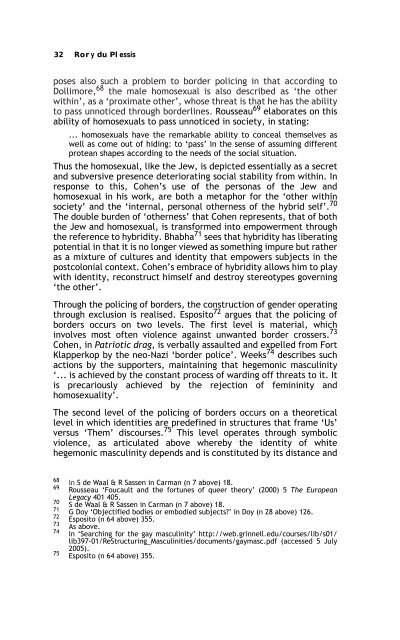Sex, Gender, Becoming - PULP
Sex, Gender, Becoming - PULP
Sex, Gender, Becoming - PULP
Create successful ePaper yourself
Turn your PDF publications into a flip-book with our unique Google optimized e-Paper software.
32 Rory du Plessis<br />
poses also such a problem to border policing in that according to<br />
Dollimore, 68 the male homosexual is also described as ‘the other<br />
within’, as a ‘proximate other’, whose threat is that he has the ability<br />
to pass unnoticed through borderlines. Rousseau 69 elaborates on this<br />
ability of homosexuals to pass unnoticed in society, in stating:<br />
... homosexuals have the remarkable ability to conceal themselves as<br />
well as come out of hiding: to ‘pass’ in the sense of assuming different<br />
protean shapes according to the needs of the social situation.<br />
Thus the homosexual, like the Jew, is depicted essentially as a secret<br />
and subversive presence deteriorating social stability from within. In<br />
response to this, Cohen’s use of the personas of the Jew and<br />
homosexual in his work, are both a metaphor for the ‘other within<br />
society’ and the ‘internal, personal otherness of the hybrid self’. 70<br />
The double burden of ‘otherness’ that Cohen represents, that of both<br />
the Jew and homosexual, is transformed into empowerment through<br />
the reference to hybridity. Bhabha 71 sees that hybridity has liberating<br />
potential in that it is no longer viewed as something impure but rather<br />
as a mixture of cultures and identity that empowers subjects in the<br />
postcolonial context. Cohen’s embrace of hybridity allows him to play<br />
with identity, reconstruct himself and destroy stereotypes governing<br />
‘the other’.<br />
Through the policing of borders, the construction of gender operating<br />
through exclusion is realised. Esposito 72 argues that the policing of<br />
borders occurs on two levels. The first level is material, which<br />
involves most often violence against unwanted border crossers. 73<br />
Cohen, in Patriotic drag, is verbally assaulted and expelled from Fort<br />
Klapperkop by the neo-Nazi ‘border police’. Weeks 74 describes such<br />
actions by the supporters, maintaining that hegemonic masculinity<br />
‘... is achieved by the constant process of warding off threats to it. It<br />
is precariously achieved by the rejection of femininity and<br />
homosexuality’.<br />
The second level of the policing of borders occurs on a theoretical<br />
level in which identities are predefined in structures that frame ‘Us’<br />
versus ‘Them’ discourses. 75 This level operates through symbolic<br />
violence, as articulated above whereby the identity of white<br />
hegemonic masculinity depends and is constituted by its distance and<br />
68<br />
In S de Waal & R Sassen in Carman (n 7 above) 18.<br />
69 Rousseau ‘Foucault and the fortunes of queer theory’ (2000) 5 The European<br />
Legacy 401 405.<br />
70<br />
S de Waal & R Sassen in Carman (n 7 above) 18.<br />
71 G Doy ‘Objectified bodies or embodied subjects?’ in Doy (n 28 above) 126.<br />
72 Esposito (n 64 above) 355.<br />
73<br />
As above.<br />
74 In ‘Searching for the gay masculinity’ http://web.grinnell.edu/courses/lib/s01/<br />
lib397-01/ReStructuring_Masculinities/documents/gaymasc.pdf (accessed 5 July<br />
2005).<br />
75 Esposito (n 64 above) 355.
















